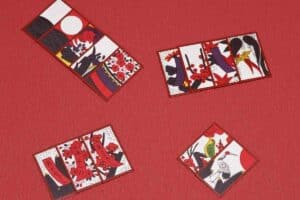Just one of a number of types of Karuta playing card, Hanafuda (Flower Cards) is a traditional Japanese set which was the initial product of Nintendo way back in 1898, when the company was first founded.
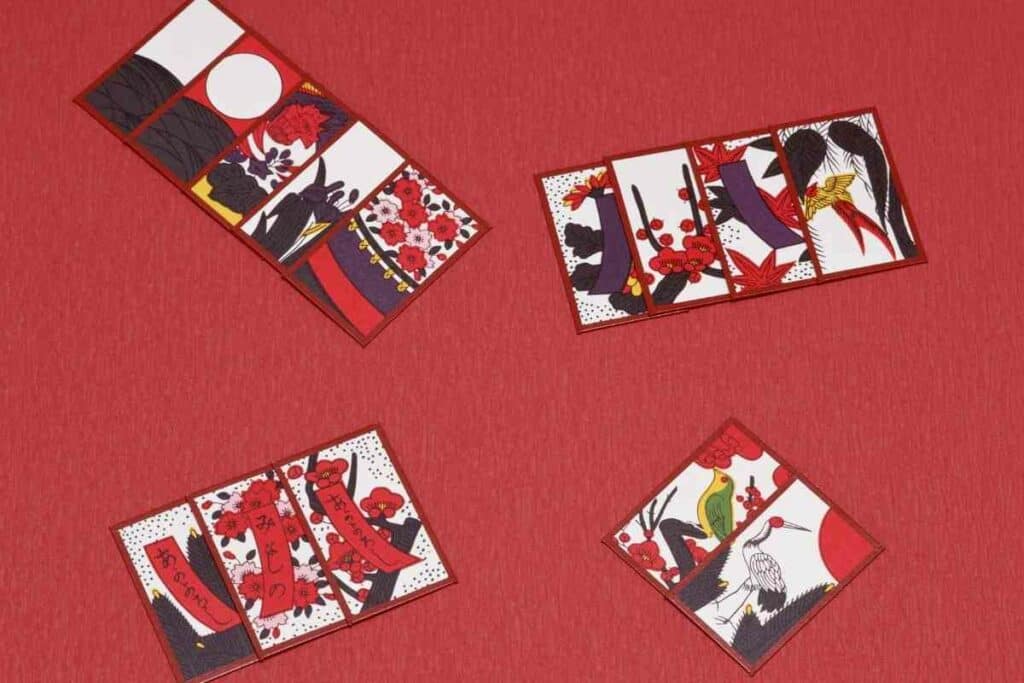
Not so dissimilar to a western deck of playing cards – these are somewhat smaller to behold – they are cut to two thirds of the size and are much sturdier in their construction.
Although their title entails flowers, decks also feature sets of animals, handmade, inanimate objects, species of bird, coloured ribbons and poetry ribbons.
In This Article – We will explain exactly what Hanafuda is, how to play some popular games and discuss the variations which have existed throughout history.
Table of Contents
What exactly is Hanafuda?
Being a Japanese card game, Hanafuda is an enjoying pastime which has existed since the 16th century.
Adapted from Portuguese decks, this infamous set were part of the Tenshõ Karuta sets and fell victim to the ban of anything remotely foreign, after Japan closed its borders to the most of the world in the mid-1600s.
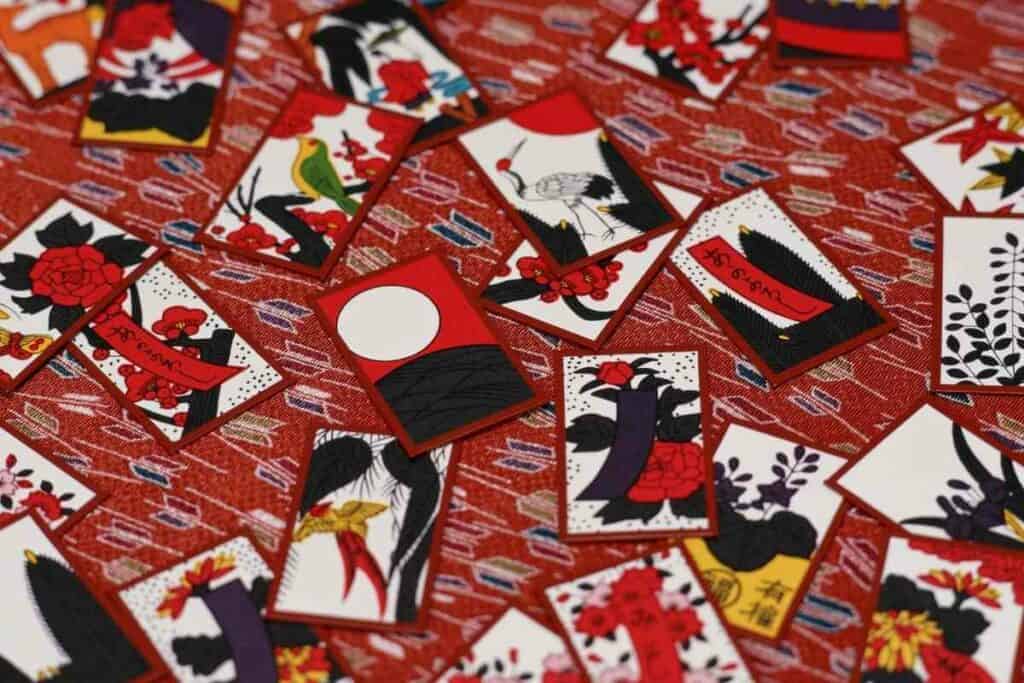
This only gave rise to more decks. When one became too well-known, it would be banned by the government.
In response to this, rebellious Japanese gamblers would create a whole new deck in a completely different style. The longer it went on, the more abstract and varied decks would become.
Today, however, decks are generally quite standardised.
What do Hanafuda cards look like?
Brightly colourful and often a joy to look at, Hanafuda cards (particularly traditional Japanese ones) can even be collectors’ items, used as decorative displays of Japanese culture.
A fraction of the size of other cards made for games, Hanafuda are a very unique adaptation of traditional, Japanese Karuta cards which can be stored quickly and easily.
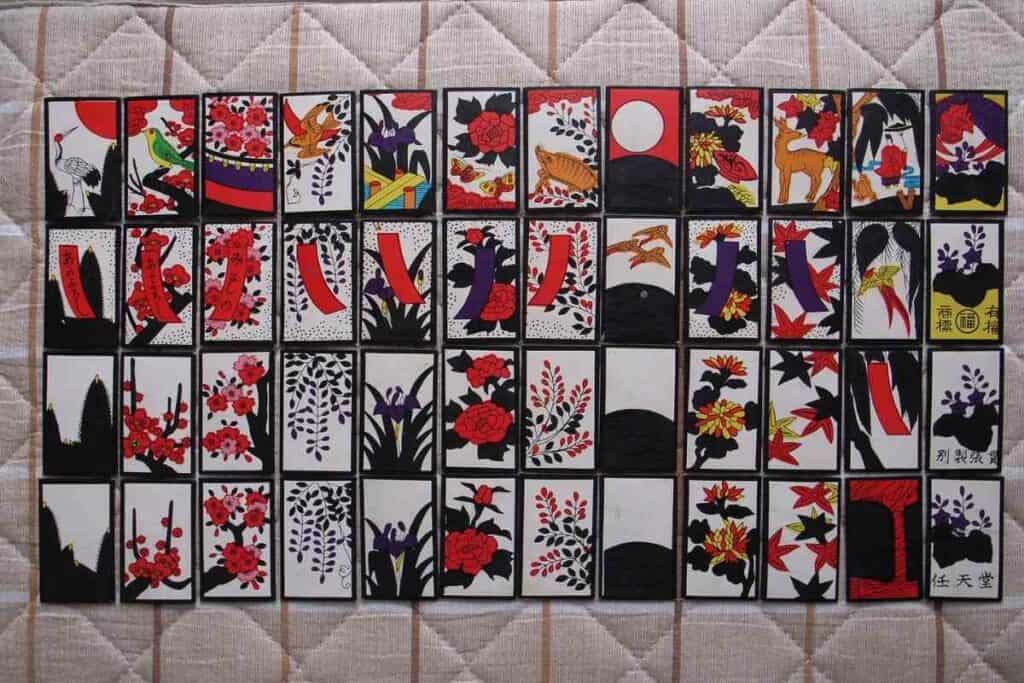
They are a deck containing 48 cards which are split into suits of 4 and are aligned with the 12 months of the year:
- January – Pine
- February – Plum Blossom
- March – Cherry Blossom
- April – Wisteria
- May – Iris
- June – Peony
- July – Bush Clover
- August – Susuki Grass
- September – Chrysanthemum
- October – Maple
- November – Willow
- December – Paulownia
Each suit has 4 cards, of which most are worth different amounts of points while some cards are worth no points at all.
- Hikari (Light) – 20 Points
- Tane (Seed) – 10 Points
- Tanzaku (Colour Paper and Wish) – 5 Points
- Kasu (Lend) – 1 Point
(These point values are adhered to in most games and a lot of contemporary decks will have the values on the cards themselves.
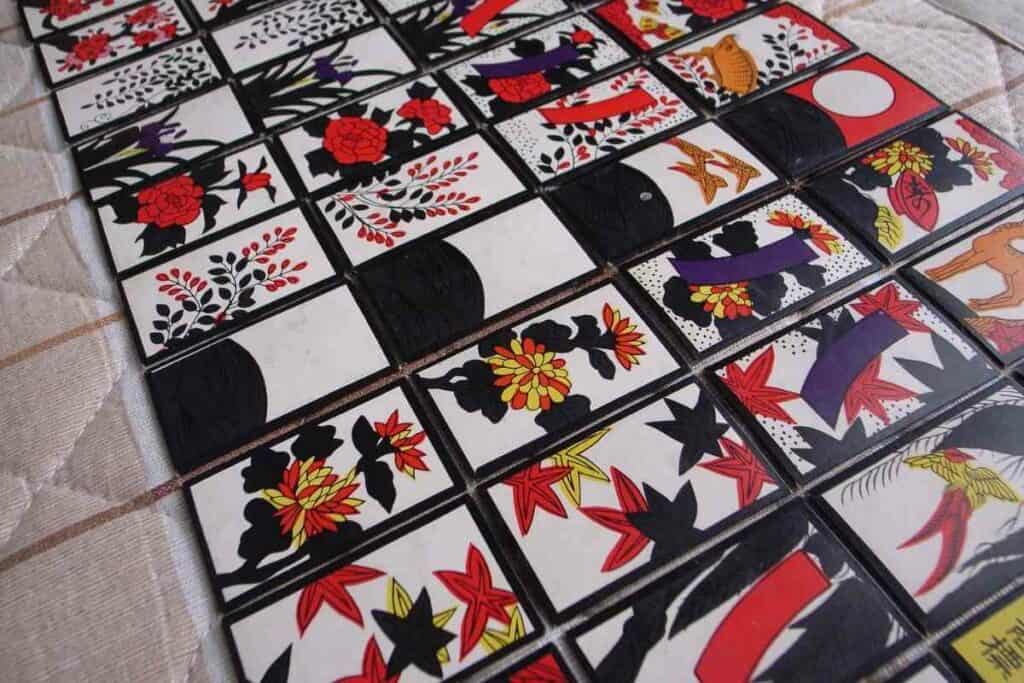
These are the values used in gameplay which is explained below).
Handmade cards can be stunning works of art but there are many manufactured decks which are also impressive to look at.
Vintage decks are also a joy to play with.
However, there are a number of decks which are incredibly popular and still produced by Nintendo.
Pokemon, Mario and other famous characters feature in some decks but to import these can be quite expensive.
As well as manufacturer markers, some of the cards contain poetry, whilst limited cards contain text in Japanese calligraphy.
Which games can you play with Hanafuda cards?
As with a standard, 52-card deck, there are many games which you can play using Hanafuda cards.
From simple pairing games, to games which are similar to Poker.
Sakura, for example, is a very popular game to play in which players collect suits in order to gain the most points and win the game.
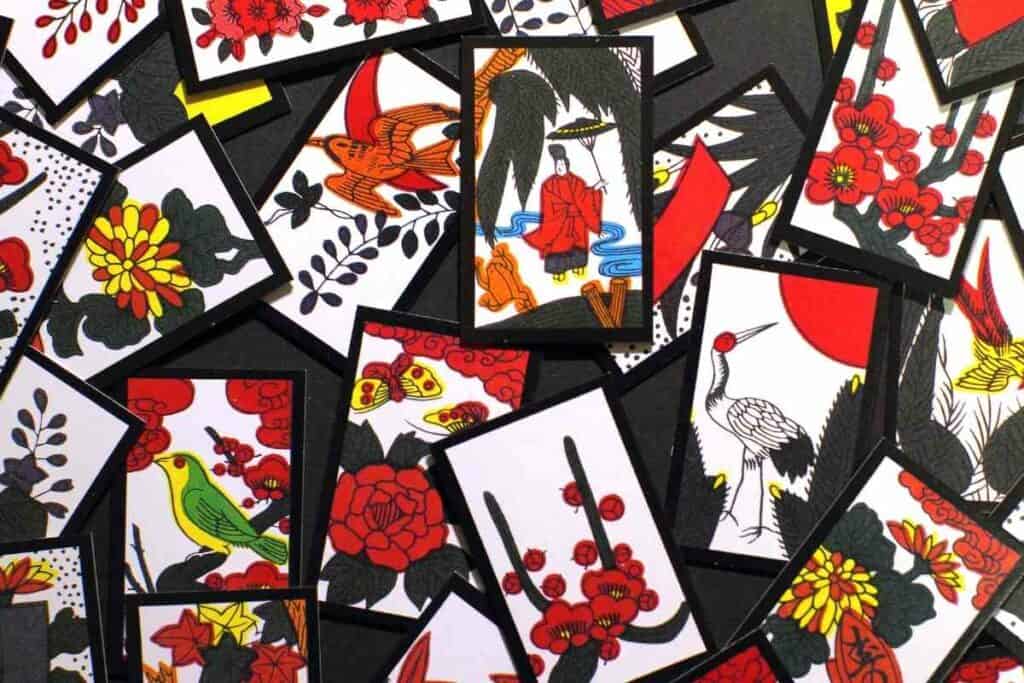
There are 3 categories of games:
- Mekuri
- Yomi
- and Kabafuda
Yomi was the original set of games including:
- Isuri
- Hiyoko
- and Poka
These were once popular in Japan but were superseded by the later Mekuri games: Hana Awase, Sakura, Koi-Koi, Mushi and Hachi – to name but a few.
Kabafuda were created specifically for gambling and is actually a unique variation of Karuta, in their own right.
Booking.comHow do you play Hanafuda?
Not such an easy question to answer when there are so many different games to play.
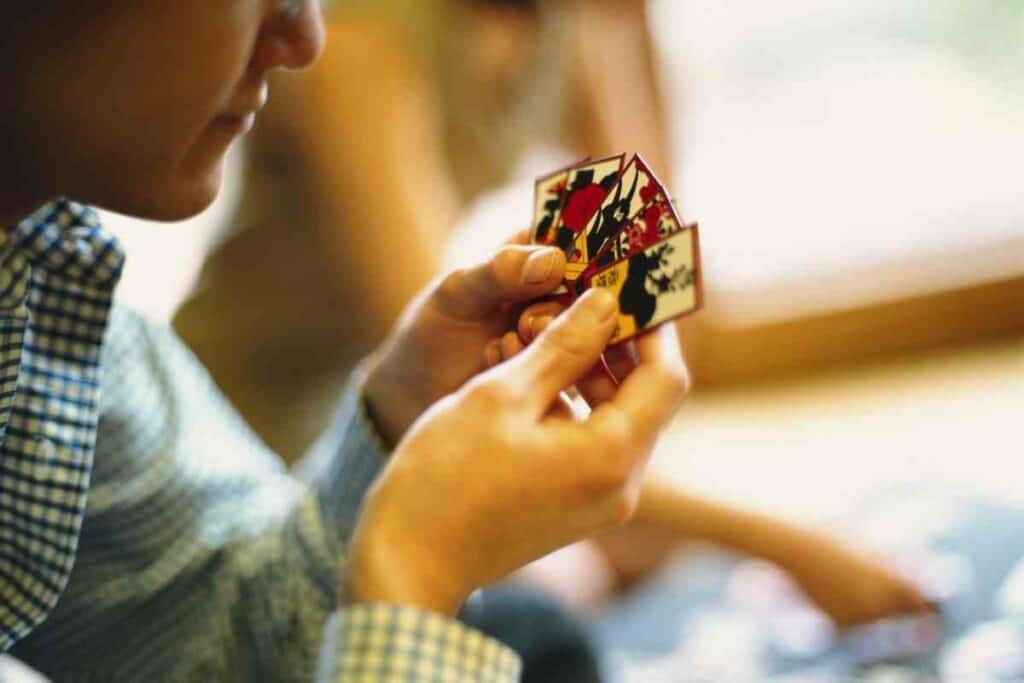
On the other hand, once you get to grips with a few games, learning new ones becomes much easier.
Here, we will focus on one specific game from the Mekuri selection: Sakura and provide you with a basic tutorial for this popular game.
How do you play Sakura?
Number of Players: 2 – 7 (Including a Dealer ‘oya’).
Aim: Collect the cards with the highest value in points, by suit, to win.
The first thing to do is select a dealer.
Each player takes a random card from the deck and the soonest month wins the role of the Dealer.
Cards per player
| Players | 2 | 3 | 4 | 5 | 6 | 7 |
| Handheld | 8 | 7 | 5 | 4 | 3 | 3 |
| Up-facing | 8 | 6 | 8 | 8 | 12 | 6 |
Order of Play: Dealer makes the initial move and play continues anticlockwise. In subsequent games, the last player starts the following game.
Length of Game: 12 Rounds, ending when all handheld cards have been played and/or the remaining deck cards run out.
Gameplay Terms:
- Field – All the up-facing cards.
- Discard Pile – Cards with no point value which have been drawn in gameplay.
- Point Set – Your collection of claimed cards and winning points – displayed close to you.
- Hiki – a set of specific rules to the gameplay.
- Wildcard – a bonus card (Lightning Storm) which is only available if it remains undealt after gameplay begins.
Taking a Turn Includes 2 Moves
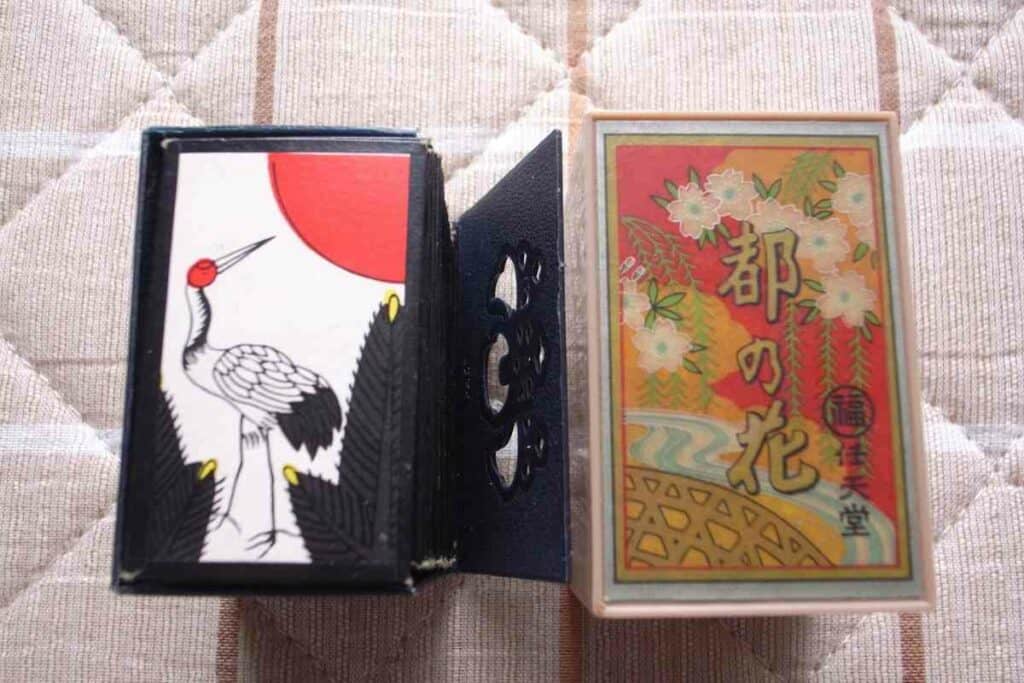
Move 1
Select a single card from your hand and place it into the Field. If it matches any card in the Field then you claim all matching cards from that same suit.
Put any claimed cards into your Point Set. If you happen to claim cards with no point value, they then go in the Discard Pile.
Move 2
Repeat Move 1, but take your next card from the remaining deck.
Using the Lightning Storm Wildcard
Should this card end up in the Field, the opportunity for its use as a Wildcard ceases to exist.
If it is flipped from the deck, then it can be placed with any card/s in the Field.
Place the Wildcard atop your chosen Field card and, at the end of the game, all remaining cards in the Field which match your chosen card, add to your final total.
Calling “Hiki!”
Hiki can be called at any time throughout the gameplay.
Should any of the players lay eyes on a complete suit, the Hiki rule allows them to shout out the word and collect them all.
This is relevant in any or all combinations. Even if 1 card is in hand and all 3 others are up-facing in the Field.
Exceptions to Hiki
An exception to this is if all 4 matching cards of a particular suit are placed into the Field, before the first move is made, then these are claimed by the Dealer.
Another is that if a flipped card from the remaining deck, presents Hiki, that player then claims them all.
Hiki cannot be called to interrupt another player’s move.
Playing with Yaku Combinations
It is recommended that playing without Yaku combinations, will be best to get new players to the game started.
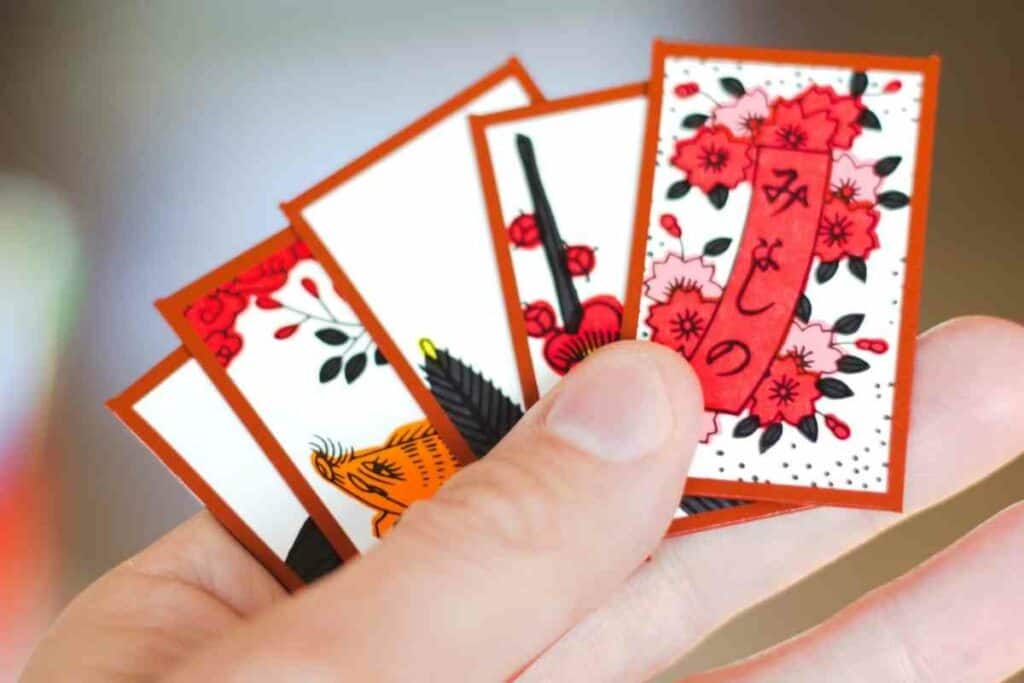
Although this is a fun variation which encourages teamplay between players, it can get a little complex.
In addition to the above gameplay, Yaku combos are calculated at the end of each round. These are trios of cards which are worth 50 reduction points for every other player.
If 2 players present a combo then 100 points come off your total. This type of addition to the gameplay can have your score going into the minus.
It certainly intensifies the competitive nature of the game.
What are the Yaku combos in Sakura?
There are 8 different combinations to be made.
Each set consists of 3 cards.
| YAKU | Card Combination |
|---|---|
| 1 | 3 Blue Ribbon Cards |
| 2 | 3 Red Ribbon Cards – Not Willow |
| 3 | 3 Poetry Ribbon Cards |
| 4 | Moon/Curtain/Sake Cup |
| 5 | Curtain/Crane/Warbler |
| 6 | Sake Cup/Deer/Butterflies |
| 7 | Bridge/Boar/Cuckoo |
| 8 | Deer, Geese, Boar |
Encouraging teamwork, you can also play in pairs for Yaku.
If you and a team player combine 3 cards between you, then you can use these against other teams in the game, at the end of the round.
Final Thoughts
Although there are many games to play with a set of Hanafuda cards, Sakura is one of the most complex and entertaining games to play.
With the option of playing as many rounds as you can manage, or playing the more complex version with Yaku combinations, gameplay can be modified to a shorter, more manageable game of just a few rounds before totalling up.
Once you have mastered Sakura, you will have a good level of familiarity with the cards and learning more games will be a walk in the cherry blossom trees.




